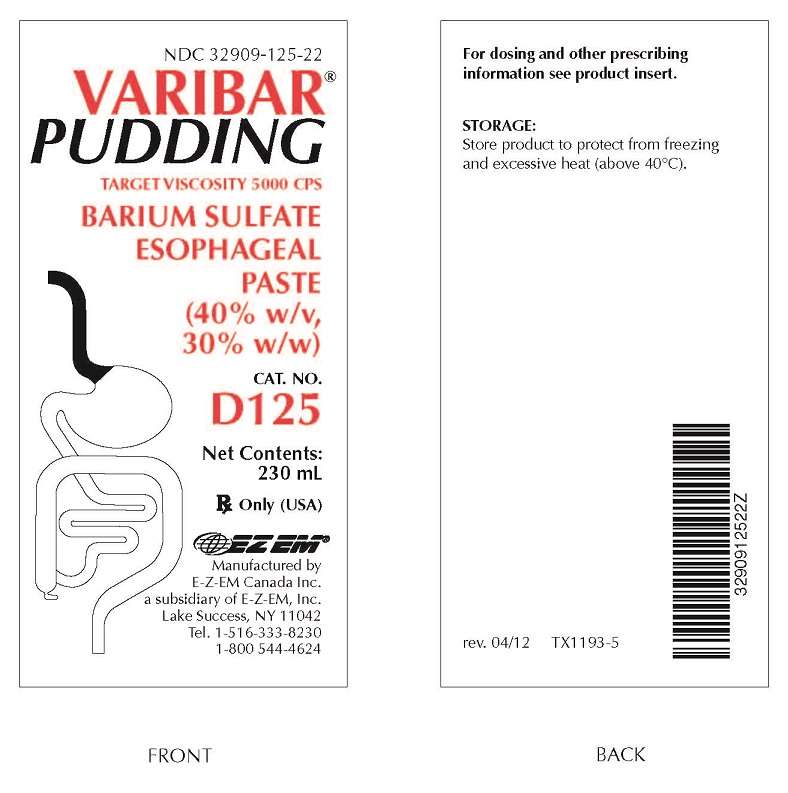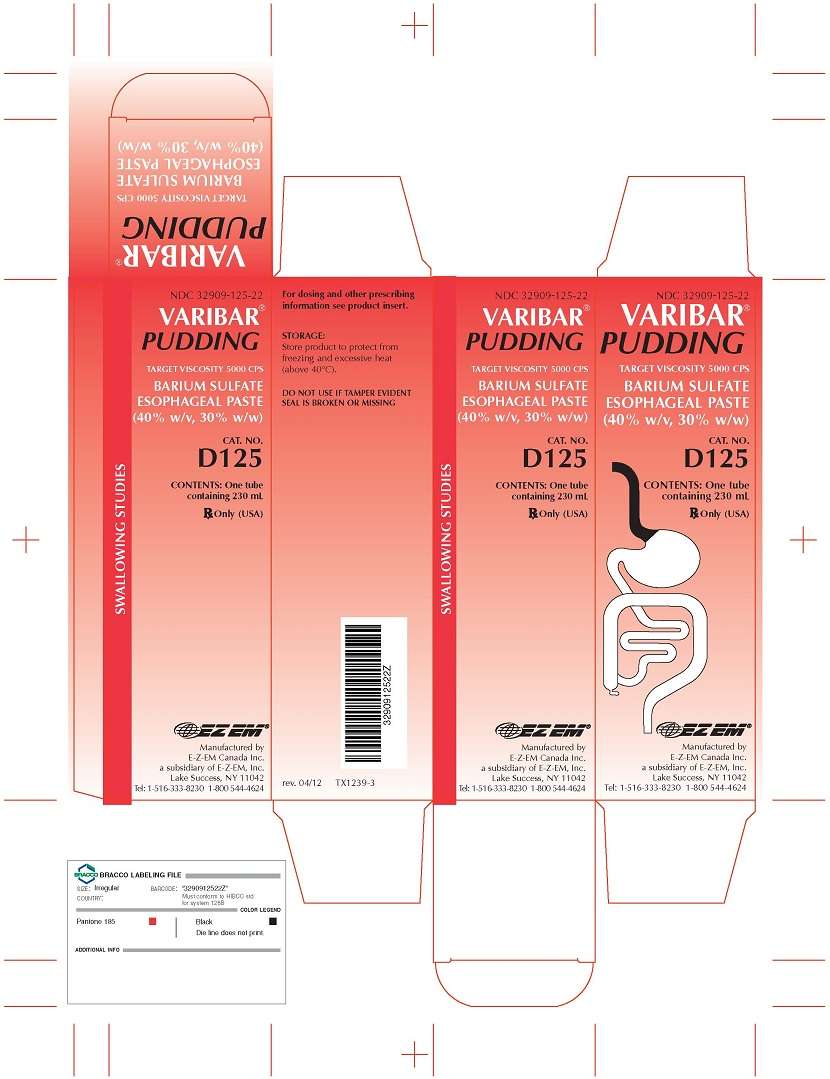Varibar Pudding
E-Z-EM Canada Inc
E-Z-EM, INC.
NDC 32909-125-22VARIBAR PUDDINGBARIUM SULFATE ESOPHAGEAL PASTE(40% w/v, 30% w/w)
FULL PRESCRIBING INFORMATION: CONTENTS*
- VARIBAR PUDDING DESCRIPTION
- VARIBAR PUDDING INDICATIONS AND USAGE
- CLINICAL PHARMACOLOGY
- VARIBAR PUDDING CONTRAINDICATIONS
- WARNINGS
- PRECAUTIONS
- VARIBAR PUDDING ADVERSE REACTIONS
- ALLERGIC REACTIONS
- OVERDOSAGE
- VARIBAR PUDDING DOSAGE AND ADMINISTRATION
- STORAGE
- HOW SUPPLIED
FULL PRESCRIBING INFORMATION
VARIBAR PUDDING DESCRIPTION
VARIBAR® PUDDING (Target Viscosity 5000 CPS) Barium Sulfate Esophageal Paste (40% w/v, 30% w/w) is for oral administration. Each 100 mL contains 40 g barium sulfate. Barium sulfate, due to its high molecular density is opaque to x-rays and, therefore, acts as a positive contrast agent for radiographic studies. The active ingredient is barium sulfate and its structural formula is BaSO4. Barium sulfate occurs as a fine, white, odorless, tasteless, bulky powder which is free from grittiness. Its aqueous suspensions are neutral to litmus. It is practically insoluble in water, solutions of acids and alkalies, and organic solvents.
Inactive Ingredients
Artificial vanilla flavor,
carboxymethylcellulose sodium, citric acid, ethyl vanillin, glycerin,
maltodextrin, polysorbate 80, potassium sorbate, purified water, saccharin
sodium, simethicone emulsion, sodium benzoate, xanthan gum and xylitol.
VARIBAR PUDDING INDICATIONS AND USAGE
This product is indicated for use in radiography of the esophagus, pharynx and hypopharynx.
CLINICAL PHARMACOLOGY
Barium sulfate, due to its high molecular density is opaque to x-rays and, therefore, acts as a positive contrast agent for radiographic studies. Barium sulfate is biologically inert and, therefore, is not absorbed or metabolized by the body, and is eliminated unchanged from the body.
VARIBAR PUDDING CONTRAINDICATIONS
This product should not be used in patients with known or suspected gastrointestinal perforation; or hypersensitivity to barium sulfate or any components of this barium sulfate formulation.
WARNINGS
Rarely, severe allergic reactions of an anaphylactoid nature, have been reported following administration of barium sulfate contrast agents. Appropriate facilities and trained personnel should be available for emergency treatment of severe reactions and should remain available for at least 30 to 60 minutes following administration, since delayed reactions can occur.
PRECAUTIONS
General
Diagnostic procedures which involve the use of radiopaque contrast agents should be carried out under the direction of personnel with the requisite training and with a thorough knowledge of the particular procedure to be performed. A history of bronchial asthma, atopy, as evidenced by hay fever and eczema, or a previous reaction to a contrast agent, warrant special attention. Caution should be exercised with the use of radiopaque media in severely debilitated patients and in those with marked hypertension or advanced cardiac disease.
Given that the contrast material is designed for a procedure that is performed to document the presence and extent of pathophysiology of the swallowing mechanism as well as to determine appropriate remediation of such, aspiration of the barium sulfate is an expected consequence for some patients. When this occurs, it is recommended that the patient be assisted in attempts to expectorate the aspirant. The study should be resumed if the clinician is prepared to assess the patient’s response to specific interventions designed to eliminate or minimize the recurrence of aspiration (postural changes, sensory enhancements, swallowing maneuvers and/or dietary changes). It is recommended that the study begin with the introduction of limited amounts of material per swallow (3 mL or less).
After any barium study of the GI tract, it is important to rehydrate the patient as quickly as possible to prevent impaction of the bowel by barium sulfate. To prevent barium sulfate impaction in the bowel, secondary to administration of large volumes of this product (i.e. >120 mL) the use of mild laxatives such as milk of magnesia or lactulose, following completion of the examination may also be required.
Use with caution in patients with complete or nearly complete esophageal or gastric obstruction.
Information for Patients
Before administration of this product patients should be instructed to:
- Inform their physician if they are pregnant.
- Inform their physician if they are allergic to any drugs or food, or if they have had any prior reactions to barium sulfate products or other contrast agents used in x-ray procedures (see PRECAUTIONS-General ).
- Inform their physician about any other medications they are currently taking.
Drug Interactions
The presence of barium sulfate formulations in the GI tract may alter the absorption of therapeutic agents taken concomitantly. In order to minimize any potential change in absorption, the separate administration of barium sulfate from that of other agents should be considered.
Usage in Pregnancy
Radiation is known to cause harm to the unborn fetus exposed in utero. Therefore, radiographic procedures should only be used when, in the judgement of the physician, their use is deemed essential to the welfare of the pregnant patient.
Nursing Mothers
Barium sulfate products may be used during lactation.
VARIBAR PUDDING ADVERSE REACTIONS
Adverse reactions, such as nausea, vomiting, diarrhea and abdominal cramping, accompanying the use of barium sulfate formulations are infrequent and usually mild. Severe reactions (approximately 1 in 1,000,000) and fatalities (approximately 1 in 10,000,000) have occurred. Procedural complications are rare, but may include aspiration pneumonitis, barium impaction, granuloma formation, intravasation, embolization and peritonitis following intestinal perforation, vasovagal and syncopal episodes, and fatalities. It is of the utmost importance to be completely prepared to treat any such occurrence.
ALLERGIC REACTIONS
Due to the increased likelihood of allergic reactions in atopic patients, it is important that a complete history of known and suspected allergies as well as allergic-like symptoms, e.g., rhinitis, bronchial asthma, eczema and urticaria, must be obtained prior to any medical procedure utilizing these products. A mild allergic reaction would most likely include generalized pruritus, erythema or urticaria (approximately 1 in 250,000). Such reactions will generally respond to an antihistamine such as 50 mg of diphenhydramine or its equivalent. In the rarer, more serious reactions (approximately 1 in 1,000,000) laryngeal edema, bronchospasm or hypotension could develop. Severe reactions which may require emergency measures are often characterized by peripheral vasodilation, hypotension, reflex tachycardia, dyspnea, agitation, confusion and cyanosis progressing to unconsciousness. Treatment should be initiated immediately with 0.3 to 0.5 mL of 1:1000 epinephrine subcutaneously. If bronchospasm predominates, 0.25 to 0.50 grams of intravenous aminophylline should be given slowly. Appropriate vasopressors might be required. Adrenocorticosteroids, even if given intravenously, exert no significant effect on the acute allergic reactions for a few hours. The administration of these agents should not be regarded as emergency measures for the treatment of allergic reactions.
Apprehensive patients may develop weakness, pallor, tinnitus, diaphoresis and bradycardia following the administration of any diagnostic agent. Such reactions are usually non-allergic in nature and are best treated by having the patient lie flat for an additional 10 to 30 minutes under observation.
OVERDOSAGE
On rare occasions following repeated administration, severe stomach cramps, nausea, vomiting, diarrhea or constipation may occur. These are transitory in nature and are not considered serious. Symptoms may be treated according to currently accepted standards of medical care.
VARIBAR PUDDING DOSAGE AND ADMINISTRATION
The dose of VARIBAR® PUDDING to be administered will depend on the degree and extent of contrast required in the area(s) under examination and on the equipment and technique employed.
STORAGE
Store VARIBAR® PUDDING to protect from freezing and excessive heat (above 40°C).
HOW SUPPLIED
VARIBAR® PUDDING is supplied in the following quantity: 230 mL tube, Cat. No. D125, NDC 32909-125-22
Manufactured by E-Z-EM Canada Inc.
a subsidiary of E-Z-EM, Inc. Lake Success, NY 11042
Tel:
1-516-333-8230 1-800 544-4624
rev. 02/14 TX1715
Varibar® Pudding - Barium Sulfate Esophageal Paste
CAT. NO.: D125
NDC: 32909-125-22

Varibar® Pudding - Box
CAT. NO.: D125
NDC: 32909-125-22

Varibar Puddingbarium sulfate PASTE
| |||||||||||||||||||||||||||||||||||||||||||||||||||||||||||||||||||||||||||||||||||||||||||||||||